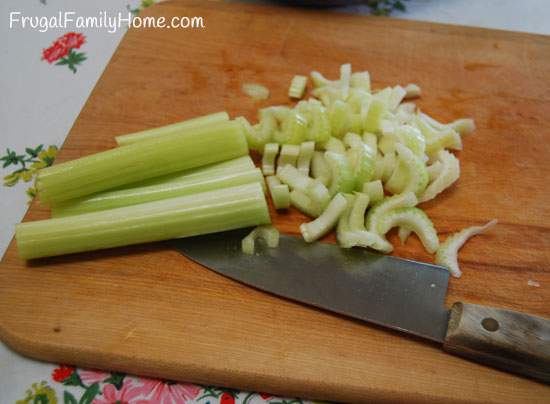Freezing and Drying Celery
Celery is one of those vegetables that can contain pesticides if not purchased organically grown. So when I spotted a deal, a while back on organic celery hearts for just $.25 a package, I snatched up 4 packages. In hindsight I should have grabbed much more if I would have remembered how easy it is to freeze or dry.

So today I am sharing the process, well it’s not really a process, the way I freeze and dry celery. Just so you will know how to preserve celery in case a great buy on organic celery comes around your way. I know I have heard of people purchasing a years worth of celery and freezing it for later use. If I would have only thought of that when I found that great deal on celery but oh well, maybe next time. 🙂
Freezing Celery
This is really hard to do, not really just joking, it’s one of the easiest vegetables I freeze. I like to remove all of the stocks from the celery root and then give them a good scrub. I also like to remove any brown spots and the ends. If you like to use the leaves leave them on. Then I just slice the celery and bag it into 1 cup portions. I use sandwich baggies and then add all the sandwich baggies to one large gallon sized bag so I can locate them in the freezer more easily. Because sometimes my freezer is not that organized, but that’s a whole other post.
Drying Celery
While I wish, long, and hope for another freezer, it’s probably not going to happen as we just don’t have the room for another one. So when I want to store more than my freezer can hold I turn to drying foods in my dehydrator. Celery dries really well and is fairly easy to do. If you slice the celery thin then just place it in the dehydrator to dry. You can do this with the leaves too. If you want a little thicker sliced celery just blanch the celery for 1 minute then cool it down under cool running water, before adding it to the dehydrator. I usually just slice it thin to save the extra step.
To Use the Celery,
I like to use the frozen celery in stir fry, casseroles and some of my stove top dishes. I just thaw slightly and use the frozen celery as I would the fresh celery in the recipe.
The dried celery works well in casseroles and soups or stews the best. It is also good in slow cooker recipes. I usually don’t bother with rehydrating the celery before I add it to the recipe. Usually there is enough liquid in the dish to hydrate the celery as it cooks.
Have you ever tried freezing or drying celery before?
[signoff]
Looking for more gardening ideas? Head on over to the gardening page for more gardening ideas and inspiration.
Get the Companion Plants List
When you join the gardening email list, you'll not only get gardening tips sent to your inbox, you'll also get the companion plants list too.





I had never thought of this before..thanks for the great tip! 🙂
Your Welcome, Debra.
I had never even thought about freezing celery. Thanks for sharing this! 🙂
I freeze celery too! I just don’t use it that much but like to add it to my homemade chicken soup. It’s so easy to grab some from the freezer to throw in the soup and I’m so happy to not be throwing out celery that went bad before I could use it. I also chop up and freeze carrots for future soups.
Tracy, I usually use celery in stir fry, pot pies and soups. I try to get any surplus into the freezer before it goes bad, sometimes I succeed other times I don’t and I offer to my neighbors for their chickens or the compost pile get fed. Your idea about freezing carrots is a great one. I could see having some soup veggies packets stashed away in the freezer to make soup prep really easy. Thanks so much for sharing it.
Is there a way to dry celery if I do not have a dehydrator?
I have not tried to dehydrate celery other than in a dehydrator but this is how I would try.
Place thinly sliced celery on a cookie sheet, you may find that blanching it for a minute in boiling water may help it dehydrate better in the oven.
Then place the cookie sheet in your oven and put your own on the lowest temperature setting.
After 4-6 hour check to see how the celery is doing, if it’s dry then your done, if it still seems to moist let to go longer. If you have a convection oven this process would go a little faster. Just keep checking about every hour. Once the celery is fully dry, let it cool and then package it up.
I have used this method on many different fruits and a few vegetables before I was able to purchase a dehydrator. If you give it a try please let me know how it works for you. 🙂
Thanks,
I will give it a try
This is on my list! I was wondering the best way to go about dehydrating celery and you’ve saved me Googling.
Thanks!!
Your Welcome, Danica!
have you every dehydrated celery after freezing it?
looking to free up some freezer space…
I haven’t tried it with celery but I have with other vegetables. So I’m sure it would work too.
Great post. I have been wanting to freeze celery but wasn’t sure how. Any tips on cleaning it & dealing with all of the strings?
Cheryle, to clean the celery, I usually cut off the bottom of the celery and then rinse from top to bottom. The dirt usually is at the bottom so it washes it out more easily this way. If you are wanting to remove the strings, I use a knife to cut a little into the end of the celery and then pull on it to peel downward and remove the strings. Although I usually don’t bother with removing the strings before freezing or drying the celery, since I slice celery first.
When I have leftover celery or onion and I don’t want it to spoil I chop it like I need it to add to soups or stews. I then spread it out on a waxed paper lined cookie sheet and cover it with another piece of waxed paper. I then put it in freezer until it freezes enough to not stick together when I put it in a zip lock bag. Then I put it in freezer to store it and when I need some I just take out the amount I need and I don’t have to worry about it freezing together in a big block.
Thanks for sharing this tip, Sis.
What about storing after dehydrating?
John, I store our celery in an airtight container in the cupboard. If you live in a humid area, you might want to vacuum seal for longer storage.